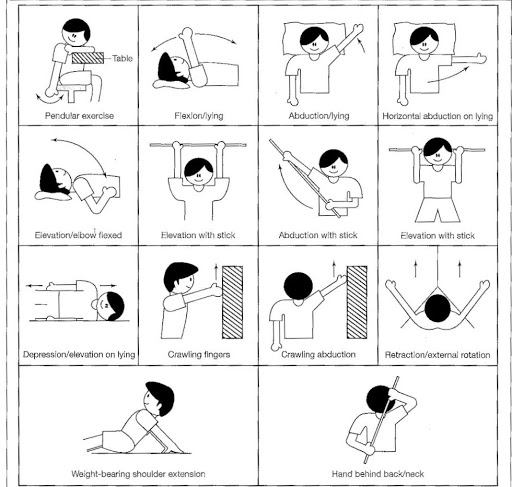Frozen shoulder or adhesive capsulitis is stiffness, pain, and limited movement of the shoulder, and there are some kids of frozen shoulder exercises out there. It can be caused by an injury, overuse of the shoulder, or a disease like diabetes or a stroke. This causes the tissues around the joints to stiffen, scar tissue to form, and shoulder movements to become difficult and painful. This condition usually progresses slowly, then after about a year or so, the problem gradually goes away, but there are some things to do and treatment. And frozen shoulder exercise is a beneficial treatment to rehab pain and discomfort.
https://youtu.be/lvEU8OcKg2k
Those who have ever had a shoulder injury before but have not been appropriately treated may have a frozen shoulder later. People who work very hard or work in the kitchen can also get this disease. Patients with diabetes or heart disease may also suffer from this problem. Most of them are in their 40s, but many of them may be before him.
These following reasons are responsible for frozen shoulder:
- Adhesive capsulitis
- Supraspinatus tendinitis
- Rotator cuff injury
- Traumatic pain
- Cervical radiculopathy
- The plaster then hardens the joint stiffness or joint
- Joint stiffness or joint stiffness after surgery
Today we will discuss some frozen shoulder exercises that can relieve you from pain and discomfort. Let’s see…
Frozen Shoulder Exercises
You can do the frozen shoulder exercise at home. Also, Some helpful frozen shoulder exercises are given below:
Towel stretch
You need to hold the towel back with both hands in the same way you usually wipe your back with a towel after bathing. Grip the towel in a straight standpoint. Operate your welfare arm to drag upwards to broaden your outspread arm. On the other hand, Stretching the towel over your right shoulders can be an improved version of this exercise. Clench the underneath of the towel over the frozen arm and grab back down with the unarmed part. Work out this 10 to 20 times every day.
Pendulum stretches
This exercise is beneficial to rehab your frozen shoulder. To do this exercise at first, relax your shoulders. The rule of thumb is to lean forward slightly and try to rotate the hand as much as possible, back and forth. You have to turn your hand 10 times in the direction where the clock is ticking. Then you have to set your hand in the opposite direction 10 more times. Thus you have to do the exercise twice a day. After two weeks, it should be replaced by weight-bearing activity. You need to start this exercise by rotating your arms with some weight on your hands. This exercise should be done according to the rules of the pendulum exercise. This exercise also has to be done 10 times clockwise and 10 times counterclockwise. Do this exercise twice a day.
Wall Climbing
In addition to pendulum exercises, wall climbing exercises can be done. To do this exercise, the patient has to raise his hands as high as he can along a wall holding a wall. Gradually try to raise the hand to a higher height. All the exercises together are called shoulder mobilizing exercises.
Crossbody reach
To do this exercise, you can use this position standing or sitting. Operate your welfare arm to raise your frozen arm to the angle and apply light pressure to extend it over your body and shoulders. Keep up the range for 15 to 20 seconds. Accomplish this exercise 10 to 20 times a day.
Finger walk
The wall of the mouth is three-quarters the length of an arm. Attain and touch the side at the abdomen phase with your affected arm’s fingers. Bend your elbows slightly and gently step your fingers over the wall like a spider until you can comfortably lift your hand. Rather than moving your shoulder muscles, you should work with your fingers. Gently lessen the good arm when you feel necessary. Rehearse this workout 10 to 20 bits a day.
Inward rotation
To do this exercise, stand next to a door. After that, swing one edge of the rubber work out the band with the door lock. Clutch your angle at a 90-degree curve and clench the different edge with the affected hand. Grab the band two or three inches toward your body and hold for a few moments. Rehearse this exercise 10 to 15 times once a day.
Outward rotation
Near your side, wear a rubber practice band at a 90-degree angle with your elbow in your hand. Swirl the bottom of the frozen arm two or three inches in or out and keep for few moments. Reiterate this exercise 10 to 15 times a day.
Armpit stretch
When you want to do this exercise, you have to use your other hand, which is not affected, and slowly lift the frozen arm on edge. The high of the side must be one-third of your hight. Slowly lean your knees and open the armpits. Bend your knees a little deeper, carefully extend the armpits. After that, you should straighten your affected arm. Remember that do not force the frozen arm, just stretch a little more with each knee fold. Work out this 10 to 20 times daily.
Symptoms
Pain in the neck joint with the hand, joint stiffness, reduced ability to move the collective, inability to sleep on the affected side, weakness in the hand, etc. However, These problems can start suddenly in one day and can start again after getting a little pain in the shoulder. Whatever the reason for the onset, whatever the problem may be, the patient is usually seen coming to the doctor with severe pain.
Causes
The leading cause of this disease is not yet known. However, in some cases, the risk of this disease is higher. Diabetes mellitus, an injury to the neck joint, if the joint has not been moved for a long time for any reason, and if there is thyroid disease after lung, heart, or hand surgery.
Treatment
If the frozen shoulder is not treated, shoulder muscles can gradually dry out. So this disease must be addressed. Do not sit with pain and numbness of the joint.
The treatment of this disease is to give a warm shake on the shoulder. Pain medications may be taken. Pain medications should be taken on a full stomach, and before taking food, take gas medications as advised by the doctor. Do shoulder exercises with the help of someone else. You may also need to receive physiotherapy. Even after taking physiotherapy, a particular type of activity (shoulder mobilizing exercise) should be done.
It takes about 18 months to cure this disease. However, if this treatment does not work, it may be necessary to give an injection in the shoulder as advised by the doctor. It may even require surgery.
Although pain seems to be the main problem for a frozen shoulder patient, his real problem is joint stiffness. The more the patient stops shaking hands for fear of pain, the harder his joint will become. Therefore, the patient should be aware that it is more important to treat hand movements than pain medications. In this case, the primary treatment method to regain the patient’s ability to move the hand while controlling the pain is proper physiotherapy treatment. However, it should be kept in mind that giving physiotherapy does not reduce the pain overnight. This requires simultaneous therapy with medication and exercise or physiotherapy. Strong painkillers NSAIDs are needed if the pain is severe. Infiltration or steroid-like joint injections may also be required under the supervision of an orthopedic surgeon. You have to try to lift a wall as high as you can.
How to prevent it?
If you have a shoulder injury, it needs to be appropriately treated. Diabetes must be controlled. Some people think that if you don’t work for a long time, you may get a frozen shoulder due to the inertia of the shoulder joint. Such an idea is not correct. On the contrary, if there is severe pressure on the shoulder joint, there is a risk of getting it. So it is never right to lift too heavy things.
In this condition, a type of fluid called synovial fluid between the joints starts to decrease. As a result, the shoulder joint gradually becomes stiff. The disease is more common in women in their 40s and 60s.
Physiotherapy on the frozen shoulder
The physiotherapist provides physiotherapy treatment in the following manner as advised by the orthopedist and according to the physical test. Manual therapy, mobilization, movement with mobilization, therapeutic exercises such as spider exercises, pulley exercises, pendular exercises, etc
That is the discomfort of the patient for shoulder pain or frozen shoulder.
- Shoulder pain is especially painful at night.
- Shoulder pain that can not sleep with the weight on the shoulder or the pain wakes up at night
- Can’t move hands properly
- Can not scratch head with hands
- Can’t take hands back
- It is difficult to wear clothes
How to diagnose a frozen shoulder?
A specialist doctor can diagnose this disease by clinical examination. However, in many cases, X-rays and some pathological tests are required.
Note point
Medication alone does not make frozen shoulders better, requiring medication as well as physiotherapy treatment.
The main point of treatment here is to normalize the shoulder joint; in this case, there is no alternative to physiotherapy treatment.
Here a specialist physiotherapist prescribes a variety of physiotherapy treatments through clinical trials.
- Manipulation therapy
- Mobilization therapy
- Laser therapy
- Electrotherapy
- Therapeutic exercises, as well as the patient, have to do some yoga.
- Wall climbing exercise
- Pendulum exercise
- Puli Exercise
- Solder wheel exercises etc.
FAQ
- What are the frozen shoulder causes?
However, in some cases, the risk of this disease is higher. Diabetes mellitus, an injury to the neck joint, if the joint has not been moved for a long time for any reason, and if there is thyroid disease after lung, heart, or hand surgery.
- What is the frozen shoulder treatment?
The treatment of this disease is to give a warm shake on the shoulder. Pain medications may be taken. Pain medications should be taken on a full stomach, and before taking food, take gas medications as advised by the doctor. Do shoulder exercises with the help of someone else. You may also need to receive physiotherapy. Even after taking physiotherapy, a particular type of activity (shoulder mobilizing exercise) should be done.
- What are the frozen shoulder exercises?
Frozen shoulder exercises:
- Towel stretch
- Pendulum stretches
- Wall climbing
- Crossbody reach
- Finger walk
- Inward rotation
- Outward rotation
- Armpit stretch
- How can I test the frozen shoulder?
In conclusion, A specialist doctor can diagnose this disease by clinical examination. However, in many cases, X-rays and some pathological tests are required.
- What are the symptoms of a frozen shoulder?







